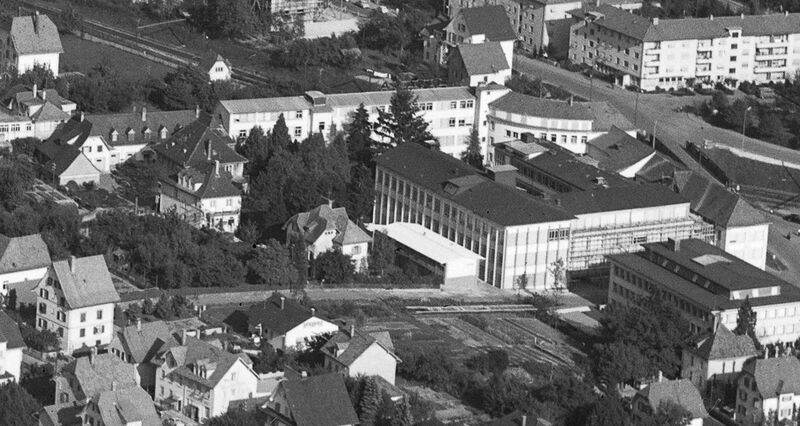Schützengasse: Difference between revisions
No edit summary |
No edit summary |
||
| (4 intermediate revisions by the same user not shown) | |||
| Line 5: | Line 5: | ||
[[File:Ins-001 1990 005 0106 Grenchen Schützengasse schematic.jpg|right|600px]] | [[File:Ins-001 1990 005 0106 Grenchen Schützengasse schematic.jpg|right|600px]] | ||
The buildings centered at Schützengasse 69 began with the [[1893]] factory of [[Jean Schwarzentrub]] and [[Arthur Müller]], later [[Hulda Grünberg]]. It was acquired by [[Adolf Schild-Hugi]] in [[1896]] before he moved his operation to the [[ | The buildings centered at Schützengasse 69 began with the [[1893]] factory of [[Jean Schwarzentrub]] and [[Arthur Müller]], later [[Hulda Grünberg]]. It was acquired by [[Adolf Schild-Hugi]] in [[1896]] before he moved his operation to the [[Mühlestrasse]] complex. It was then used as a factory for pendant watches called [[Steiner & Co]] (Oskar Steiner, Arnold Niederhäuser, Adolf Wullimann, Henry Sandoz, Peter Weber, Adolf von Burg, Arnold Barrer, Philipp Kaufmann) from 1899 to 1904. | ||
In [[1904]] the building became the headquarters of [[Adolf Michel]]'s [[A. Michel|namesake company]], which had been founded in [[Lengnau]] in 1898. This became a [[Société Anonyme]] in 1918 and founded [[Ebauches SA]] in [[1926]] with [[A. Schild]] and [[FHF]]. | In [[1904]] the building became the headquarters of [[Adolf Michel]]'s [[A. Michel|namesake company]], which had been founded in [[Lengnau]] in 1898. This became a [[Société Anonyme]] in 1918 and founded [[Ebauches SA]] in [[1926]] with [[A. Schild]] and [[FHF]]. | ||
Other tenants included the oxidation workshop of Emil Schild (1925-1927), while the East wing was used by [[Felsa]] starting in 1941. The building was continually expanded and renovated through the 1960s but was closed after 1980. | Other tenants included the oxidation workshop of Emil Schild (1925-1927), while the East wing was used by [[Felsa]] starting in 1941. The building was continually expanded and renovated through the 1960s but was closed after 1980. | ||
The landmark factory is not currently part of [[ETA]], though the company does operate a small modern administrative and services office across the street at Blumenrainstrasse 1 as building W04. The landmark complex currently houses two [[Swatch Group]] companies: [[CDNP]] (Centre de Développement des Nouveaux Produits), an R&D and market research organization, and [[MECO|MECO Suisse]], a maker of components including threaded crowns. | |||
Building Notes: | Building Notes: | ||
Revision as of 23:47, 30 April 2024
The Schützengasse complex in Grenchen is best known as the home of A. Michel but also housed many other firms, including Obrecht & Cie and Felsa.
The complex faces the Schützengasse bridge over the railroad but only tangentially touches this namesake boulevard at the extreme southwest corner. It is actually bounded by the lower Dammstrasse to the south, Blumenrainstrasse to the west, residential buildings to the north, and industrial buildings along the railroad to the east. The Villa Michel has a Däderizstrasse address because of a long driveway.

The buildings centered at Schützengasse 69 began with the 1893 factory of Jean Schwarzentrub and Arthur Müller, later Hulda Grünberg. It was acquired by Adolf Schild-Hugi in 1896 before he moved his operation to the Mühlestrasse complex. It was then used as a factory for pendant watches called Steiner & Co (Oskar Steiner, Arnold Niederhäuser, Adolf Wullimann, Henry Sandoz, Peter Weber, Adolf von Burg, Arnold Barrer, Philipp Kaufmann) from 1899 to 1904.
In 1904 the building became the headquarters of Adolf Michel's namesake company, which had been founded in Lengnau in 1898. This became a Société Anonyme in 1918 and founded Ebauches SA in 1926 with A. Schild and FHF.
Other tenants included the oxidation workshop of Emil Schild (1925-1927), while the East wing was used by Felsa starting in 1941. The building was continually expanded and renovated through the 1960s but was closed after 1980.
The landmark factory is not currently part of ETA, though the company does operate a small modern administrative and services office across the street at Blumenrainstrasse 1 as building W04. The landmark complex currently houses two Swatch Group companies: CDNP (Centre de Développement des Nouveaux Produits), an R&D and market research organization, and MECO Suisse, a maker of components including threaded crowns.
Building Notes:
- I (1894-present): This two-story gable roof building was constructed in 1894 and expanded west to Blumenrainstrasse over the next 20 years. It included a gas power plant initially, later updated with a petrol generator and transmission. In 1918 it was expanded and new facade constructed.
- II (1916-1956): A separate factory building was constructed here in 1916 but this was demolished in 1956 as the complex was expanded and modernized.
- III (1910-1956): This L-shaped wing was added between buildings I and II in 1910, built by Josef Wyss. It was expanded by Müller & Farge in 1918 but was torn down and replaced by a new building in 1956-1957.
- IV (1918-present): The East wing, including the landmark concave connection to Building I, was built in 1918-1919 by Müller & Farge. The facade includes an open 10 segment gable with clock, flanked by female and male figures by sculptor Etienne Perincioli. It was renovated and updated around 1960.
- V (1901-1956): The original factory store was built around 1901. It was replaced by a staff canteen on the upper floor (welfare building) in 1919 by Hans Lehner (Rüdtlingen). Like buildings II and III it was replaced by the new building in 1956-1957.
- VI: Villa Michel, home to the Michel family
- VII: Utility building
